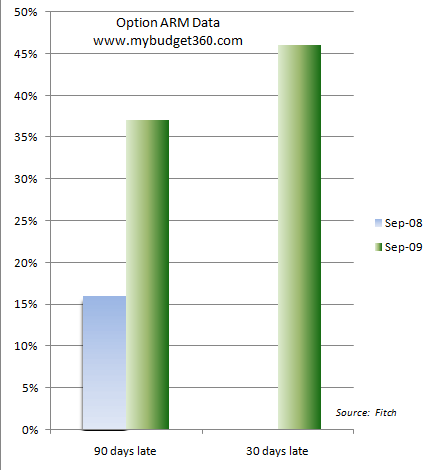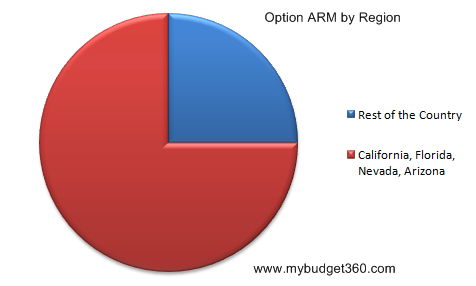Option ARMs, the dubious name for a mortgage product of financial destruction, are back in the limelight showing that they have not gone away. Everyone by now has heard about option ARMs. These toxic mortgages allowed borrowers a buffet of payment options. However, in recent data released this week we are told that things are much worse than we had initially thought. Option ARMs have now become an oxymoron. In fact, they should be called minimum payment mortgages because 94 percent of those who took on these mortgages elected to go with the minimum payment.
These loans are having default rates comparable to subprime loans. In states like California with a decade long housing bubble, option ARMs were a lucrative and inviting mortgage for quick talking mortgage brokers chasing big yields. But one thing is certain and that is these mortgages are here for the next few years and will cause additional problems.
Many have speculated that most of these loans have been modified. Well in the recent report put out by Fitch Ratings, only 3.5% of the approximately 1 million option ARM loans have been modified. That is right, only 3.5% (or if you like, about 35,000 loans). And modifications are no panacea. In fact, of the tiny number of modified option ARMs 24 percent re-default after 90 days while the untouched loans default at a rate of 37 percent after 90 days. These numbers will increase. And why would anyone expect that a loan modification will help? For the most part, all that is done is the term is extended, or interest is cut, but the bank is still able to claim the home is worth the bubble price and therefore allows the bank to keep the “asset” on the books for full face value. What does this mean? More losses coming down the road. And look at how quickly these loans are going bad with new data:
As of today, 46 percent of option ARM loans are 30 days late! Nearly half the entire batch of these loans. And most of these loans were made by the likes of defunct Washington Mutual in states like California, Arizona, Nevada, and Florida. In fact, 75 percent of all outstanding option ARMs are in these states:
Of the currently $189 billion in option ARM loans outstanding, 70 percent will recast in the next two years. Some people wanted to believe that this problem was swept under the rug but it is anything but. In fact, expectations for losses range from 35 to 45 percent assuming home prices do not decline in the areas where these loans are made. Well if you look at California, the state with the most option ARMs it has an unemployment rate of 11.9 percent and just patched up $60 billion in budget deficits. The losses will be bad. Assuming the 45 percent loss ratio, we are looking at $85 billion in losses simply from option ARMs. So much for the optimistic banking scenario.
What makes these loans so insidious is banks are holding onto these mortgages as if they were at face value. Some banks have allocated loss reserves for these loans but nothing in the 45 percent range. They are overly optimistic as usual but these loans are defaulting in mass.
Another reason for the massive amount of defaults is the severity of their negative equity. When these loans were made, loan-to-value ratios were roughly at 79 percent. They are now at 126 percent. One thing about this data point. Many of these loans were made in conjunction with piggy-back products so that 79 percent is deceptive. Many option ARMs were combined as an 80/20 or 80/10/10 loan. So many of these loans are attached to homes with at least two mortgages. The second mortgage disaster is going to hit in full force soon as well and good luck trying to recover anything from the second loan after the foreclosure process happens.
Banks are delaying foreclosure as long as possible. They are stalling and wheeling and dealing with Washington praying that they can somehow artificially juice the market to unload these loans. Tax credits and other incentives are simply cheap methods of creating an artificial market to unload this junk to the average American. Banks simply do not want to come to terms with option ARMs and the public for the most part has assumed many of these loans were modified. 3.5% is nothing especially if we consider that a loan mod constitutes extending the loan term. All that does is makes the loan a longer term option ARM and gives the bank breathing room to devise of ways to offload the mortgage to the taxpayer.
All these loans are negatively amortizing. In fact, as the home values have plummeted the mortgage balance has increased. This is pure financial moonshine. When these loans will recast even with favorable interest rates thanks to the U.S. Treasury and Federal Reserve annihilating the U.S. Dollar, the typical payment will readjust to 63% higher than the original minimum payment. In many cases, it will double.
Referring back to our original chart, we see how many are already 30 days late and only 12 percent of all outstanding option ARMs have recast. As we enter 2010, many of these vintage loans from 2004-2007 will start hitting their 5 year explosion dates. Some have pointed out that Wells Fargo has some 10 year Pay Option ARMs but clearly that is a tiny part of the entire pool. Bottom line is this, 70 percent of these loans will recast in the next 2 years and banks are trying everything they can to offload this toxic mortgage potato to the taxpayer like every other mistake they have done during this decade.
by mybudget360 in bailout, banks, debt, foreclosure, mortgages, option arms, real estate

No comments:
Post a Comment